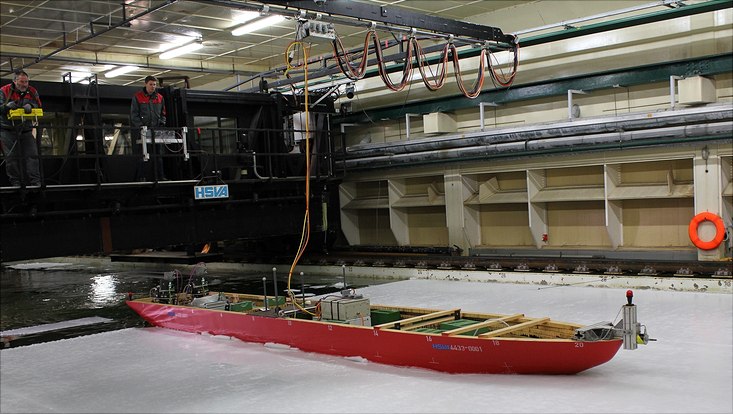19 December 2024
Collaboration between the University of Hamburg and The Hamburg Ship Model BasinNew Ice Model for More Sustainable Shipping Expeditions

Photo: The Hamburg Ship Model Basin
“We want to develop an ice model that includes the mechanical properties of summer ocean ice,” explains the project’s initiator, Dr. Niels Fuchs from the Cluster of Excellence Climate, Climatic Change, and Society (CLICCS) at the University of Hamburg. This, he continues, is softer and less brittle than winter ice. The number of ships in the Arctic has been increasing for years, especially in the summer, but they are not very well adapted to the summertime ice. “The ships, which can navigate the Arctic Ocean usually only in the summer, could be designed more efficiently,” says Fuchs.
CLICCS researchers want to develop a “recipe” for model ice, which, like normal ice, consists of frozen water, in the upcoming year. Subsequently, the recipe will be used in the ice tanks at The Hamburg Ship Model Basin (HSVA). “With this project, we want to save on emissions, resources, and fuel while increasing the efficiency and economy of the ships,” says Nils Reimer, project head at the HSVA.
A model of pack ice or a boat will be built in the HSVA for this purpose. For trials that are true to scale, the ice structure also has to be minimized. Subsequently, model ships will navigate this ice cover and measurements of the power they require will be taken. This makes it possible to ascertain which interactions between the hull, the machine, the engine, and the propellers make the ships most efficient.
Ice researcher Niels Fuchs also wants to closely study the properties of Arctic ice. He is primarily interested in the way the ice in summer behaves in small pools of melting water. These kinds of changes have an enormous impact on how much warmth ocean ice in the Arctic can absorb. The findings also yield important data for climate prognoses. “The HSVA halls provide a unique opportunity for modeling conditions in the Arctic,” says Fuchs.
In addition to the University of Hamburg and the HSVA, the Hamburg University of Technology (TUHH) is involved. They are further collaborating on the HamburgIceLap, a platform to strengthen exchange between industry and research in Hamburg. The project is called SMiLLA, which stands for “Sommer-Modell-Eis für universelle Laboranwendungen”—in English, summer ice model for universal laboratory applications. Researchers receive funding from the Transferring Research into Practice office of the Federal Ministry of Education and Research. Niels Fuchs is also hoping to pursue further knowledge exchange projects in which the new model ice and ice labs can be used. After all, other maritime infrastructure such as offshore wind parks can be adapted to the future conditions of polar ocean ice.
